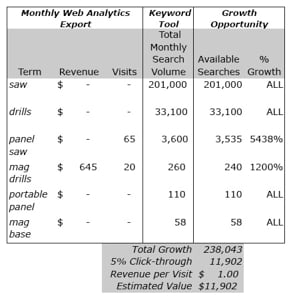The perception that search engine optimization is a limitless source of free traffic and sales is one reason that SEO campaigns sometimes fail to live up to expectations. Yes, SEO efforts can deliver excellent returns on investment. But how much expected return is realistic? This article will help you estimate the potential growth in traffic and sales that SEO efforts can drive to your site.
First, you need to know how much traffic and sales natural search drives to your site today. Start by mining your web analytics program to export the amount of natural search-referred traffic and sales that each keyword has driven in the last month. For example, let’s say that you sell power tools online. After you scroll past the keywords for your brand, your web analytics may include terms like track saw and magnetic drill press. You’ll end up with the spreadsheet below left.

If your business is highly seasonal, choose the time period for the data export carefully – you may need to repeat this exercise for a couple of recent months.
Now you know the keywords and phrases for which you’re already capturing natural-search-referred traffic and sales. How does that compare with the available keyword market – the number of searches that are actually performed in an average month on those keywords and phrases?
To determine the current rate of success, use a keyword tool like KeywordDiscovery.com or Google Adwords Keyword Tool. For each exact keyword and phrase that drove traffic to your site, record the total number of searches your keyword tool estimates.
From this point, a simple calculation of (TotalSearches-YourTraffic) / (YourTraffic) equals the percent growth opportunity for the keywords and phrases for which your site is already driving traffic. For example, if total Google searches for the keyword phrase track saw is 10,000 and the traffic to your site from that phrase is just 1,000, the percentage growth opportunity would be (10,000-1,000)/1,000, or 900%!
But don’t stop now. The most interesting upside typically comes from the keywords and phrases for which your site is not driving traffic and sales today.
Everything we’ve discussed so far has been concrete, objective data for a known quantity of keywords and phrases. Identifying the keywords and phrases that your site should be winning in natural search traffic and sales is one part science and one part art. To determine what additional traffic and sales natural search could be driving to your site, you have to engage in some in-depth keyword research. Identify the words for which your site offers relevant content, and then identify the most popular ways of searching for that content using your keyword research tool. The value of the keyword research is entirely dependent on the degree to which it 1) mirrors the relevancy of your site’s content and 2) encompasses the types of search terms that real users use. For more pointers on keyword research, try PJ Fusco’s keyword research primer.

For example, working from the keyword phrases panel saw and mag drills, which are already generating some natural-search-traffic sales, you might observe that your site isn’t driving traffic from saw, portable panel saw, drills, and mag base drills.
Once all of the data has been collected, sum the “Total Monthly Search Volume” column to identify the total SEO traffic upside. Remember that this number theoretically represents 100% of the natural search traffic available. Research shows that a position 1 ranking will average about 45% of the available click-through. So if you rank #1 for saw, which represents, say, approximately 201,000 searches a month, approximately 90,450 of those searchers (45%) would click through from Google to your site. However, I recommend using a more conservative 5% click-through rate in estimating the opportunity that SEO represents for your site.
If you know the average revenue value each visit represents, you can also estimate the value of optimizing your site to achieve those additional natural search-referred visits.
Moreover, a spreadsheet like this can be sorted by the growth columns to identify the keywords and phrases that represent the biggest growth opportunities, giving you a prioritized list of content topics to optimize.
Since the examples are based on six keywords and phrases, they are a fraction of the total opportunity to be estimated on the keyword research for an entire site.
Notice that ranking data is conspicuously missing from this formula. Rankings are quick and easy snapshots of SEO progress, which is why site owners love to focus on them. It’s generally true that the higher the ranking, the larger the traffic will be from that keyword. But, thanks to personalization, vertical search, blended search and a number of other factors, rankings are notoriously unreliable as indicators of SEO progress. Stick to traffic, sales and keyword research as the basis of your SEO upside estimations and you’ll be able to reliably set expectations for SEO success.





